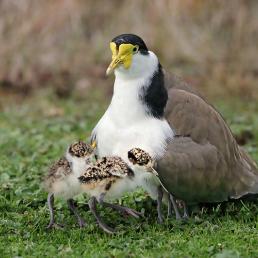

Join BirdNote tomorrow, November 30th!
Illustrator David Sibley and actor H. Jon Benjamin will face off in the bird illustration battle of the century during BirdNote's Year-end Celebration and Auction!
In autumn, millions of North American waterfowl – like these Redheads – migrate south. They come from Alaska, the prairies and forests of Canada, the Pothole region of the Dakotas, and Eastern Montana. Their arrival is awaited by birders and hunters alike. Because waterfowl are a vital natural resource, the birds and the conditions of their nesting habitats are surveyed every year.
To learn more about the results of the spring 2013 surveys, see Related Resources below.
BirdNote®
Counting North America’s Waterfowl
Written by Todd Peterson
This is BirdNote.
[Loud quacking of female Mallard]
In autumn millions of waterfowl stream south. They come from Alaska, the prairies and forests of Canada, the Pothole region of the Dakotas and Eastern Montana. Their arrival is avidly awaited by birders and hunters alike. [A Gadwall landing]
Because we value them so highly, waterfowl, and the condition of their nesting habitat are surveyed every year. Air and ground crews from the U.S. Fish and Wildlife Service and the Canadian Wildlife Service conduct the count. They’re assisted by state, provincial and tribal agencies and the conservation organization, Ducks Unlimited.
In May biologists and observers fly fixed-winged aircraft at about 150 feet throughout North America’s waterfowl breeding grounds. [Sound of two-seater float plane flying] “The survey covers more than 55,000 linear miles, representing more than 2 million square miles of the northern United States and Canada.” 1/ Findings are augmented by helicopter and ground surveys. [It’s the most extensive waterfowl census in the world.]
The results include specific estimates for ten species of ducks. Those estimates play a big part in determining hunting seasons and harvest limits. 2/
With plentiful moisture in many breeding areas, recent years have seen record numbers of waterfowl coming south in the fall flight. But to ensure the perpetual return of this precious resource, the survey crews will be back in the air next May.
[Female Mallard quacking and chatter of male Mallards]
To see a map of the waterfowl survey areas (3/), begin at our website: birdnote.org
###
Bird sounds provided by The Macaulay Library of Natural Sounds at the Cornell Lab of Ornithology, Ithaca, New York. Quack of female Mallard [3420] recorded by A.A. Allen; chatter of male Mallards [3430] by A.A. Allen; landing of Gadwall [43090] by W.W.H. Gunn.
BirdNote’s theme music was composed and played by Nancy Rumbel and John Kessler.
Producer: John Kessler
Executive Producer: Chris Peterson
© 2013 Tune In to Nature.org October 2013 Narrator: Michael Stein
ID# waterfowl-01-2013-10-17waterfowl-01
1/ http://www.ducks.org/conservation/waterfowl-surveys/waterfowl-breeding-…
2/ http://www.ducks.org/conservation/waterfowl-surveys/2013-duck-numbers?p…





